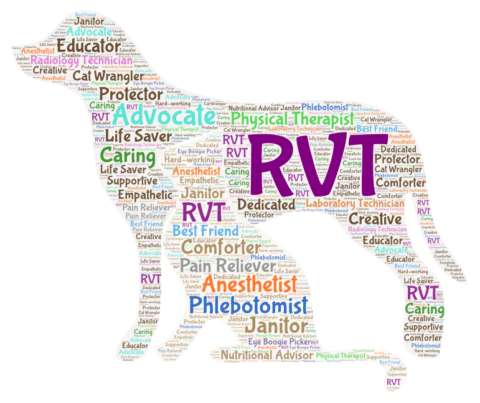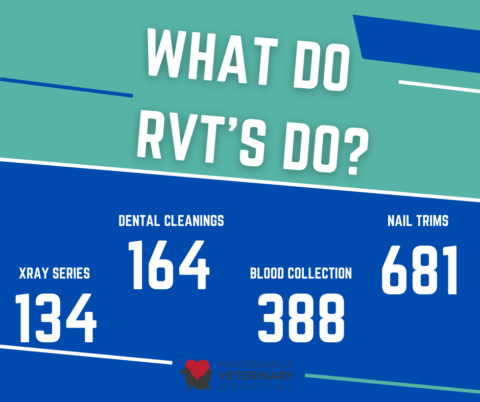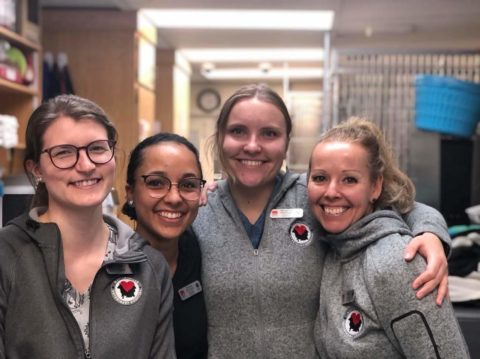You know that super cool pocketknife that does everything? “Oh, you have a bottle to open?” Pulls out super cool pocketknife, “Let me get that for you!”. “Ouch! Broken nails suck! I have a nail file, want to use it?” Out comes the pocketknife! Imagine if that super cool pocketknife that ‘can do everything’ existed in a veterinary clinic. Wouldn’t that be amazing? Well, we’re here to tell you that it does but it’s not something you can fit in your pocket. It’s a person, a registered veterinary technologist (RVT).
Veterinary technologists (VTs) start their career by going through a grueling, 2-year diploma program. Once they have obtained their diploma, they then need to pass a national exam (VTNE) to become a registerable VT. The final step is registration. In Saskatchewan, VTs are registered with the Saskatchewan Veterinary Medical Association (SVMA). In order to maintain their registration, they must stay in good standing with the SVMA and the Saskatchewan Association of Veterinary Technologists (SAVT) and they must put in at least 10 hours of continued learning yearly.

Within the clinic, RVTs have many roles. Some are exciting: anesthetist, dental hygienist, phlebotomist, laboratory and radiologic technologist. Other are less glamourous: janitor, mortician, and groomer.
Let’s elaborate on only a few because if we touched on them all we’d be here all day! In their anesthetist role, RVTs induce and monitor general anesthesia under the direction of a DVM (Not sure what DVM stands for? Read this blog!). This sounds simple, but it really isn’t. It starts with an IV catheter, then we move to induction medications given, endotracheal tube placed, patient prep, move patient to surgery, hook patient up to monitoring equipment, monitor patient, recognize normal and abnormal values, understand what changes need to be made to correct abnormalities or when further medication is needed, troubleshoot issues, administer intra-operative and post-operative medications, and recover the patient.
When RVTs put on the dental hygienist pants, they perform dental radiographs, chart the mouth, and scale the teeth, followed by some polishing. They also apply oral treatments like Sanos. All of this is done while they are keeping an eye on things like patient positioning and anesthetic depth.
While wearing the phlebotomist hat, RVTs safely collect blood samples from patients. This role follows through into the lab tech role where RVTs are responsible for sample handling, lab tests, and lab maintenance.
In the radiologic tech role, RVTs position the patient and take radiographs. This requires knowledge of anatomy and handling, allowing the RVTs to get the images that their DVMs need. Each radiologic series performed can consist of 2-4 images.
The less glamourous are just as important as the exciting roles. Keeping the clinic clean is paramount to performing good medicine. At MVH, RVTs can’t take all the credit for this. We have kennel techs and tech assistants who take care of a lot of the day-to-day cleaning. Thank goodness we have them!
In their sad role of mortician, RVTs tend to the aftercare of the deceased. Again, at MVH we have our amazing KTs and TAs, but there aren’t a lot of clinics who have them so this falls to the RVTs to do.
As groomers, RVTs perform anal gland expressions and give pets horribly ugly lion cuts (We try to make them nice, we really do!) They also do a lot of nail trims. Now nail trims can seem simple, and a lot of the time, they are. But vet clinics also see the untouchables. The ones groomers attempt and say, “Heck nah!”. The thrashy, pony sized dogs that kick as hard as horses and can take you for ride. They also do a lot of client education, like showing people how to trim their pets nails (don’t say we’ve never tried to save you a buck) or giving advice on which comb or brush would likely suit their pet’s needs.
Speaking of client education, this is a HUGE part of the RVT role in the clinic! Many people assume RVTs went into the profession because they love pets. That is definitely true, but they don’t stay in clinic long if they don’t also like people. Part of the joy of being an RVT comes from helping clients improve the health and wellbeing of their pet through husbandry, behavior, and nutrition discussions.

Now that we’ve covered a trivial portion of what RVTs do, let’s look at some numbers for all you numbers driven folk. Between January 1st and September 24th, of this year, our RVTs collected blood more than 388 times. They did 681 nail trims and obtained radiographs on 134 patients. They also performed 164 dental cleanings. If we take this further, there were approximately 218 days during this timeframe that the clinic was open. This is where the number work gets messy because it doesn’t work out to whole numbers and we sure as heck don’t do 1.3 dental cleanings daily. What would that even look like? On average, our RVTs will do 3 nail trims daily but this number doesn’t include a lot of those demos we mentioned earlier. And the math works out to not quite 1 patient going into the x-ray suite daily, which makes sense because luck tends to throw 5 radiology cases at you on the same day (and there is your whole number). For the blood collection, we get 1.8 patients daily. Now recall, we mentioned that along with that collection comes running the desired test(s), so it isn’t just a ‘collect and move on’ situation; there’s follow though that has to be completed.
RVTs are amazing, passionate, multi-talented people and that certainly goes for our RVTs. Wendy, Kate, Simone, and Mackenzie are individually unique, and each brings something different to our clinic. They are our super cool pocket knives!

From left to right: Erin, VA and VT student. Simone, RVT. Mackenzie, RVT. Wendy, RVT. Missing: Kate, RVT




